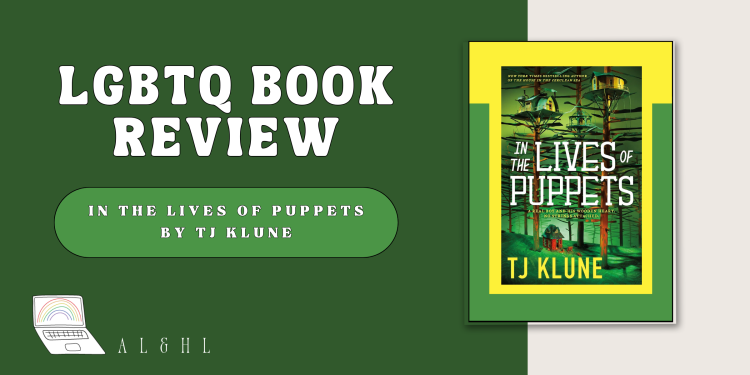Welcome to another LGBTQ book review! All reviews touch on genre/plot, tropes (if any), quality of LGBTQ content, and avoid most spoilers. Catch up on my last book review of Inverse Cowgirl by Alicia Roth Weigel. You can find all LGBTQ book reviews here.
In the Lives of Puppets: LGBTQIA Book Overview
Genre/Plot
Victor lives with his adoptive father and two robot friends isolated in a forest. When he repairs a third robot friend and loses a drop of blood in the process, the authoritarian government destroys his home and kidnaps his father. Vic and his friends leave their home for the first time to find their creator.
Characters/Relationships
Victor is asexual, which his friend, Nurse Ratched, a repaired health professional robot announces early in the book. Victor’s romantic attraction remains unlabeled throughout the story.
When Victor repairs the humanoid robot Hap–short for Hysterically Angry Puppet–a slow burn develops. Victor breathes life and consciousness into Hap by crafting him a beating heart instead of a battery pack. We assume the heart enhances a robot’s humanlike emotional qualities.
LGBTQIA content assessment
Victor’s asexuality is given a very matter-of-fact treatment to it. Readers understand that this is something he’s known about himself for a long time, and the information is presented explicitly as innate to him. It comes with a brief explanation of what this means, but in a way that is well-integrated into the story. It does not stick out like a “here’s a lesson to learn.”
One of the well-known, very powerful/influential robots that our main characters meet later on uses they/them pronouns. Their gender is not a discussion; neither are their pronouns. It fits easily within the parameters of the narrative.
Given the futuristic setting (unknown years into the future, at least centuries from now), the queer stuff is all non-issue. It’s never a complication. There’s no internalized homophobia. (Or externalized homophobia on the surface.)
In the Lives of Puppets: Some spoilers
So, no homophobia on the surface is super cool. Instead, In the Lives of Puppets uses allegorical techniques to tell a queer people vs. society story. When Victor and his friends reach the genderless Blue Fairy, they learn of the underground methods the Blue Fairy and their allies operate. The authoritarian government of the city knows the Blue Fairy aids robots in their desires to explore repressed feelings, but allows the Blue Fairy to do so because of deals cut behind the scene, etc. etc. It’s giving “gay bars that police will raid often but not shut down because they are paid off by the mafia to not fully criminalize its existence.”
Additionally, the only way robots in this world can explore their curiosities around feelings of all kinds is by doing so in shadow, on the fringes of society. To live with feeling as a robot–to feel human–is to go against the Authority, punishable by “decomission” aka wiping your memory and getting reprogrammed. Very conversion therapy-eseque.
In the Lives of Puppets tells a tale of queer history under the guise of dystopian future, avoids obvious homophobia of all kinds, and still includes gay characters and themes. Win! Win! Win!
Consider sparing $3 to support my blog! Also, AH&HL now has a commissions menu!


2 thoughts on “LGBTQ Book Review: In the Lives of Puppets by TJ Klune”